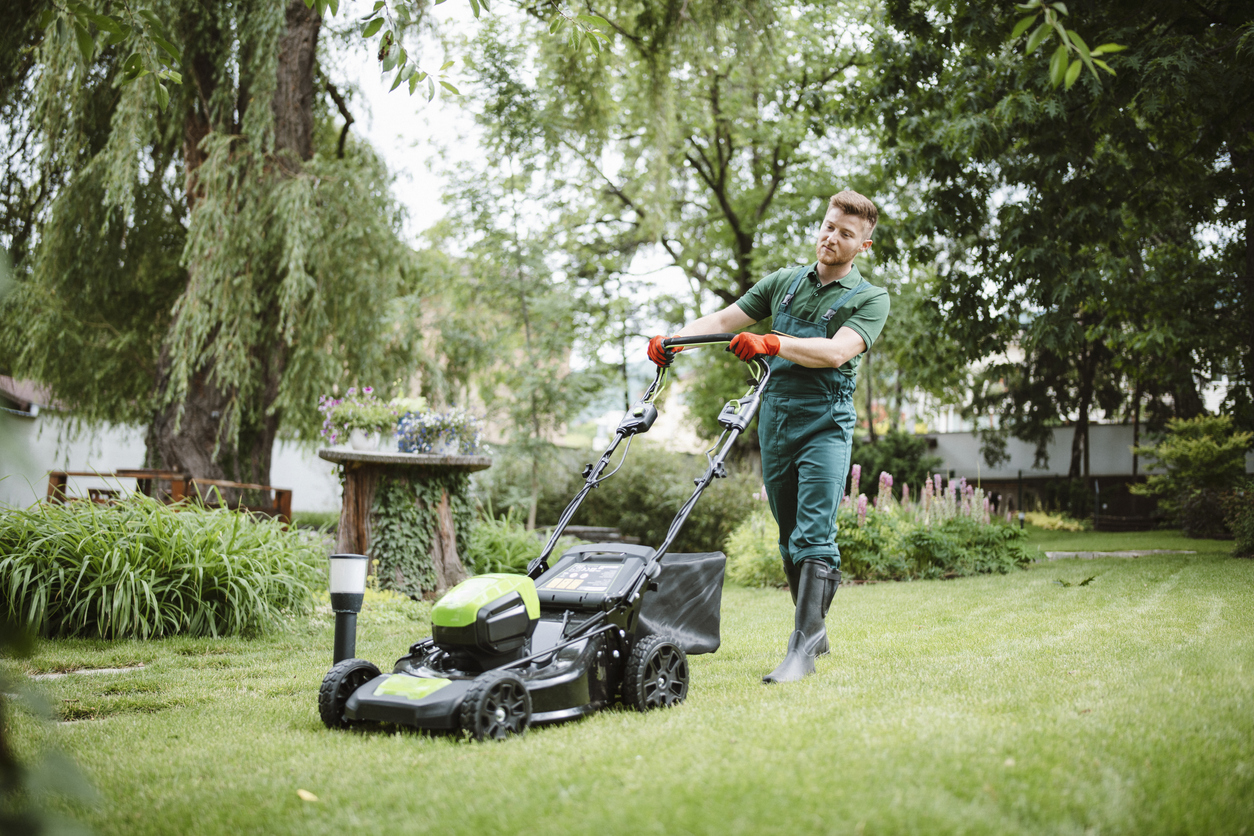How to Market a Landscaping Business and Land More Clients
KEY TAKEAWAYS
-
Identifying your ideal client and market helps tailor your landscaping services, focusing on property size, seasonal needs, budget, and customer lifetime value.
-
Establishing a strong online presence through a mobile-friendly website, Google Business Profile, and social media engagement is critical for attracting and retaining clients.
-
Leveraging content marketing (such as blogs, seasonal guides, and video content) alongside paid ads and referrals can boost brand visibility and generate leads.
-
Regularly tracking marketing performance using KPIs (such as lead conversion, customer acquisition costs, and ROI) allows for continuous strategy optimization and business growth.

Landscaping businesses face a tough challenge: standing out in a crowded market and attracting steady clients. But with more homeowners and commercial properties investing in professional lawn care services, the opportunity for growth has never been greater.
Successful landscaping marketing isn’t about flashy tactics but about understanding your audience, leveraging digital tools, and creating genuine connections with potential customers. By implementing a comprehensive marketing approach, lawn care businesses can transform their customer acquisition and grow their bottom lines.
1. Identify your ideal client and market
Before you start your marketing efforts, you have to know who you’re marketing to. That means defining your target audience for lawn care services across residential and commercial clients. You’ll want to outline detailed ideal customer profiles (ICPs) and categorize them based on factors like:
- Property size and service area coverage
- Seasonal lawn maintenance needs
- Budget allocation for landscaping services
- Potential lifetime customer value
There is a four-step process you can use to help guide your target audience identification. By the end of these four steps, you should have a good understanding of who you’re marketing to.
- Determine your services: Identify what services you’ll offer to your customers, think about who is most likely to purchase those services, and define your unique value proposition (what sets you apart from your competition).
- Research your market: Scope out your competitors and see who they are targeting, the demographics they appeal to, and the gaps you can fill. Online tools like SEMRush and Ahrefs help you view competitors’ website traffic data.
- Create buyer’s personas: The demographic data we mentioned earlier comes into play here, as you will want to create imaginary people who fit your ideal client’s profile. These profiles allow you to dial in your services, find the right customers to target, and understand who not to waste time on.
- Choose your marketing channels: Does your ideal customer hang out online, or are they more likely to respond to print advertisements? Decide which avenues are most worth pursuing to attract the attention of your target audience.
The market analysis will likely be the toughest part of identifying your ideal client. But it’s a vital step you cannot skip, so here’s a deeper look at that process:
- Study how competitors market their services: What words, phrases, or images do they use? What colors, slogans, or designs do they implement? Do you see sponsored posts, or do they leverage word-of-mouth advertising? On what social media platforms are they most active?
- Identify gaps in your local market: Does your competition fail to consider residential properties? What about apartments or new constructions? Does your service area have enough seasonal providers for things like snow removal and pest control?
- Understand and stay updated on green industry trends: Are you offering clients the latest in tools and techniques when you service their property? Can you adapt to new landscaping trends like native grass planting or xeriscaping?
- Analyze potential business growth in your service area: Can you create partnerships with land developers to secure exclusive contracts? How about real estate agents and lease management companies? Long-term contracts offer stability to support continued growth.
Through this process, you’ll fill in demographic, location, and pain point details. You’ll understand what your competition does well and how you can differentiate yourself with tailored messages and services that resonate with your audience.
2. Establish a strong online presence
Yesterday, the phone book was the place your business had to be. Today, it’s the internet. A comprehensive digital portfolio of landscaping services with customer testimonials and online reviews presents social proof for visitors.
To establish a strong online presence, you’ll need to:
- Set up a dedicated, mobile-friendly business website: You can hire a website design agency or create your own using a platform like Squarespace or Wix. You’ll use this website to share your contact details, service area information, client testimonials, specific offerings, and more. Set up a page with a contact form to collect potential customer data and sync it directly with your customer relationship management (CRM) software.
- Claim your business on Google: Completing your Google Business Profile is essential for local search visibility. Plus, it provides an easy way for potential clients to find your contact information, business details, and customer reviews.
- Engage on social media: Platforms like Facebook, Instagram, and even LinkedIn can give you a direct link to your ideal customer base. Use these channels to share things like before-and-after photos, behind-the-scenes looks, employee shout-outs, and new services.
- Continuously optimize and update: In addition to following search engine optimization (SEO) best practices, this also means keeping your information up to date and cohesive across all digital spaces, so customers have access to the most current information about your landscape business.
3. Develop a content marketing strategy
Buyer personas and a digital presence are the foundation of your landscape marketing strategy. Next, you’ll need to attract viewers by developing a content marketing strategy. Strategy can take many forms depending on the marketing channels you decide to utilize.
- Online: SEO blog posts, pay-per-click (PPC) advertising, email marketing, and your website
- Offline: Print advertising, billboards, TV and radio, and direct mail advertising
- Referral: Rewards programs, referral bonuses, affiliate marketing
- Advanced: Influencer partnerships, sports sponsorships, interactive and AI-generated marketing
An omnichannel strategy (using multiple channels) is most effective, but that doesn’t mean you have to use every channel. Test out a few different channels to see which ones deliver the best results, then lean into those top performers to maximize your ROI without sacrificing significant time. So the initial framework will look something like this:
- Plan themes, key events, or topics that are most important to your target audience using a spreadsheet.
- Pick a posting cadence and stick to it. For example, schedule blog posts for Tuesday evening and social media posts every other day first thing.
- Pre-produce content using your schedule and topics. Take advantage of pre-schedule features in the tools you use.
- Interact with your audience, share posts with employees, and engage with similar posts from others.
- Refine your strategy depending on what works and what doesn’t produce results.
Not sure what type of content to share? Consider what your audience will find most valuable, such as:
- Educational posts about lawn care services
- Tips for lawn maintenance and garden planning
- Seasonal landscaping guides
- Success stories from satisfied customers
- Video marketing featuring landscape industry expertise on YouTube
- Downloadable resources like checklists, how-to guides, and ebooks
- Social media content highlighting specific events, projects, or services
4. Choose the right marketing tools
With strategy, personas, and an online presence in place, we can move to tool selection. Digital tools and online platforms allow you to put your marketing strategy in motion and manage it from a centralized place.
You’ll want to look for tools like:
- Landscape CRM for tracking current and potential customers
- Email marketing software to send newsletters and deals
- Social media manager to schedule posts and centralize engagement
- Lead generation and form capture tools for landing pages and pop-ups
Free tools are excellent for small, independent operations, but as your business grows, you’ll need a more stringent evaluation process. Evaluate potential landscape marketing tools based on:
- Integration with existing systems
- Cost vs. potential ROI
- Ability to generate high-quality leads
- Support for advertising campaigns
- Ease of use for team members and back office staff
- Usage costs (both short and long term)
- Customer service and technical support
- Ability to create marketing materials within the tool
- Review management capabilities
All-in-one tools offer the easiest pathway to get up and running with the least amount of effort, but an industry-specific platform will have the most valuable tools for your business.
RealGreen’s suite of digital and print marketing features allows you to deploy everything from sales chatbots to email marketing automation—with a single portal to control everything. We designed these capabilities with the landscape industry in mind, with targeted tools to help you cut through the noise and focus on what drives the most value.

5. Leverage social media and email marketing
Social media crossed more than 5.22 billion users in 2024, presenting a massive opportunity for business owners. Social media apps have built-in business tools to increase brand awareness, showcase landscaping services, engage with local customers, and share current client success stories.
For example, Facebook and Instagram have the Meta Business Suite platform, which allows you to schedule posts, interact with comments, and invest in paid social media advertisements. And it’s not just Meta—you can also create a LinkedIn Page to target community business owners, share industry insights, and connect with fellow landscaping professionals.
And while email marketing might sound a little old-school, the channel continues to grow, with nearly 4.6 billion users, making it a goldmine for your landscape business. Leverage email marketing strategies to deliver content straight to customer inboxes, such as:
- Welcome sequences for new clients
- Seasonal promotions
- Client newsletters
- Special offers for existing customers
Email marketing software supports these strategies with tools that connect to your preferred email platforms and CRM contacts. They also have pre-built templates for things like welcome emails or special promotions, which you can customize to fit your brand.
6. Build a referral and review program
Word-of-mouth marketing remains one of the most effective ways to attract new customers. A well-structured referral program, combined with strategic review management, helps your business grow while building credibility within your market.
Start by developing a formal customer referral program that rewards satisfied customers for spreading the word about your business. Initiate a tiered reward system that offers increasing benefits based on the number of successful referrals. For example, current clients might receive:
- A 10% discount on their next service for each new customer referral
- Seasonal maintenance packages at reduced rates for multiple referrals
- Exclusive access to premium lawn care services for top referrers
- Special priority scheduling during peak seasons
The key to a successful referral program is making it easy for existing customers to participate. Provide them with clear instructions, shareable digital content, and multiple ways to submit referrals through your company website or mobile app.
Online reviews also play a crucial role in helping potential customers choose a landscaping company. To encourage customers to leave online reviews:
- Send follow-up emails after service completion with direct links to your review profiles
- Train your lawn maintenance teams to ask satisfied customers for reviews
- Offer small incentives like entry into monthly drawings for review submissions
- Respond promptly to all reviews, both positive and negative, to show active engagement
Ideally, you want customers to leave reviews across different channels for comprehensive coverage, and one good tactic is to alternate between platforms each month or quarter. For example, you might provide clients with a link to rate your services on Google or Facebook one month, then change the link to an industry-specific site like HomeAdvisor or Angi the next.
But you’ll need to engage with these reviews promptly to cultivate your image. Leaving bad reviews unanswered is a quick way to signal that customer satisfaction isn’t a priority, while responding to positive reviews reinforces to your customers how much you value them.
To develop a systematic approach to gathering and managing reviews:
- Set up automated review requests through your CRM system
- Monitor online reviews across all platforms daily
- Respond to new reviews within 24 hours
- Share positive reviews across your marketing channels
- Address negative feedback professionally and promptly
7. Network and partner with local businesses
Actively networking with local businesses and participating in community events allows you to market your landscaping services while building long-term relationships that generate high-quality leads.
Start by joining your local Chamber of Commerce and business associations, where you’ll connect with other small businesses and potential commercial clients. These organizations often host networking events that establish valuable partnerships and increase brand awareness for your landscaping company.
Home and garden shows are also particularly valuable venues for showcasing your lawn care services. These events help you connect with prospective clients who are actively seeking landscaping solutions.
You can also develop strategic partnerships with real estate agencies to take advantage of a potentially lucrative avenue for your landscaping business. Realtors frequently need reliable lawn maintenance services for properties they’re selling, and they are excellent sources of referrals.
Similarly, property management firms often require ongoing landscaping services for multiple properties, such as condos, apartments, and townhomes. They provide a steady stream of commercial clients and help you grow through consistent, repeat business.
And don’t overlook opportunities to partner with complementary providers in your service area, such as irrigation specialists, hardscape contractors, or pest control companies. These partnerships can lead to mutually beneficial referral arrangements and allow you to offer more comprehensive services to your existing customers while attracting new clients.
You might even create joint promotional campaigns with other local businesses. For example, you could partner with a home improvement store to get your business on their referral list or work with a garden center to provide exclusive deals to their customers.
Remember that networking is an ongoing process that requires consistent effort and genuine relationship building. Maintain regular communication with your partners and connections, attend community events consistently, and always look for ways to provide value to your business network.

8. Measure and optimize your marketing performance
Successful landscaping marketing strategies require a data-driven approach to positively impact business growth. To acquire that data, you must carefully track key performance indicators (KPIs) to identify trends and adjust your approach.
In addition to tracking key metrics, you’ll want to experiment with A/B testing and segmentation to dial in your message and delivery. Some landscape management software includes AI tools and analytics that help you identify trends and behaviors to maximize ROI.
Key lawn care marketing metrics to track
The right KPIs paint a picture for landscaping businesses to measure success, optimize marketing strategies, and drive sustainable growth. While many landscape management platforms will automatically calculate these metrics for you, it’s essential you know why they’re important to track in the first place.
Here are the essential marketing KPIs landscape companies should consistently monitor:
Lead generation
- Number of new customers acquired monthly: Directly reflects the effectiveness of your marketing efforts in growing your business
- Cost per lead across different marketing channels: Helps you allocate marketing budgets for maximum return
- Lead conversion rate from initial inquiry to booked service: Indicates how effective your sales process turns inquiries into paying customers
- Percentage of leads from referral programs: Shows the strength of your word-of-mouth marketing and customer satisfaction
- Qualified lead volume by service type (residential vs. commercial): Refine your target marketing efforts and resource allocation
Customer acquisition
- Customer acquisition cost (CAC): Determines how profitable a given marketing strategy is
- Average time from lead to first service: Indicates how efficiently your sales process moves customers through the sales funnel
- Conversion rate through the sales funnel: Highlights potential bottlenecks within the sales process
- Customer lifetime value (CLV): Guides marketing strategies to generate long-term, high-value customers
- Retention rate for repeat customers (CRR): Shows how satisfied customers are with your business
Financial performance
- Monthly and annual revenue (MRR/ ARR): Shows exactly how much your business makes monthly and annually and highlights health and growth patterns.
- Revenue growth rate (RGR): Reveals market position and business momentum
- Profit margin per service type: Provides insight into service offering and pricing strategies
- Average transaction value (ATV): Tracks service offering pricing, upsell opportunities, and service package refinements
- Return on marketing investment (MROI): Determines which marketing activities deliver the best financial returns
Marketing channel performance
- Website traffic and engagement rates (page views, time on site, unique visitors): Gauges your digital presence and content strategy effectiveness
- Social media interaction metrics (likes, shares, comments, clicks): Shows brand engagement and community-building success
- Email marketing open and click-through rates (CTR, email open rates): Demonstrates your nurture campaign effectiveness and content relevance
- Performance of Google Ads and PPC campaigns (ad spend per customer): Signals paid advertising spend and targeting effectiveness
Customer satisfaction
- Online reviews and ratings: Influences potential customers’ decision-making
- Customer feedback scores (NPS): Predicts customer loyalty and advocacy
- Referral rate from existing customers: Reveals service quality and customer satisfaction levels
- Service completion satisfaction percentage: Identifies areas for operational improvement
- Response time to customer inquiries: Affects customer perceptions and satisfaction levels
Digital marketing
- Search engine ranking for key service terms: Impacts organic lead generation and market visibility
- Organic website traffic: Highlights the effectiveness of your SEO and content marketing efforts
- Mobile website engagement: Reflects the accessibility of your digital presence for mobile customers
- Local search visibility: Illustrates your ability to capture customers in your local area
- Content marketing engagement rates: Shows the relevance and value of your marketing materials
Operational KPIs
- Service area coverage expansion: Tracks business growth and market penetration
- Number of new service offerings: Indicates your business’s adaptability and market responsiveness
- Seasonal service demand fluctuations: Helps you optimize marketing spend and resource allocation throughout the year
- Marketing expense as a percentage of revenue: Ensures sustainable marketing budget relative to overall revenue
- Lead generation efficiency: Measures the overall effectiveness of your marketing ecosystem
9. Invest in paid advertising and promotions
Paid advertising is another excellent marketing strategy for landscaping businesses to attract new customers and increase brand visibility. Unlike content marketing, paid advertising and promotions are more short-term strategies, meaning the time horizons are within a few days or weeks.
Paid ads on Google and social media offer granular targeting options, allowing lawn care companies to advertise to highly specific audiences and capture high-quality leads through local service ads, search campaigns, and remarketing efforts.
Meanwhile, direct mail campaigns complement digital marketing by enabling targeted neighborhood outreach that showcases seasonal services and promotional offers. You can even partner with leasing offices and real estate agencies to distribute these high-quality print ads in move-in packets.

10. Create a landscaping marketing calendar
A comprehensive marketing calendar is a powerful tool for planning and executing promotional activities throughout the year. Your marketing calendar should outline and organize specific marketing channels, including digital marketing efforts, direct mail campaigns, social media content, and email marketing strategies.
You can also use a seasonal marketing strategy to capitalize on peak service periods. Create targeted campaigns that align with spring lawn maintenance, summer landscaping projects, and holiday-themed promotions.
Track key dates, seasonal trends, and local community events and update marketing materials and timing to maximize engagement. Implement a flexible yet structured marketing calendar to stay proactive, responsive to market changes, and consistently visible to your target audience throughout the year.
11. Continuously refine your marketing strategy
Of course, without a constant eye on your progress, you’ll be shooting in the dark. Your metric data will tell you how well you are doing. It will also inform you of areas for improvement, making your marketing a constantly shifting effort.
You’ll want to stay up-to-date with industry trends and best practices in order to maximize your impact. The landscaping industry will never surprise a well-studied business owner, and there are plenty of resources for you to stay in the know.
Take your landscape marketing to the next level with Real Green
Marketing your landscaping business is an ongoing journey of strategic planning, digital innovation, and customer relationship building. To make the most of your marketing efforts, you must have flexibility, data-driven insights, and a multi-channel approach to reach and retain clients.
Using the strategies we covered here, your landscaping business can create a robust marketing framework that drives growth and establishes brand credibility.
Ready to take your landscaping marketing to the next level? Request a demo of RealGreen’s landscape management software today and unlock powerful tools designed specifically to help your business thrive.


